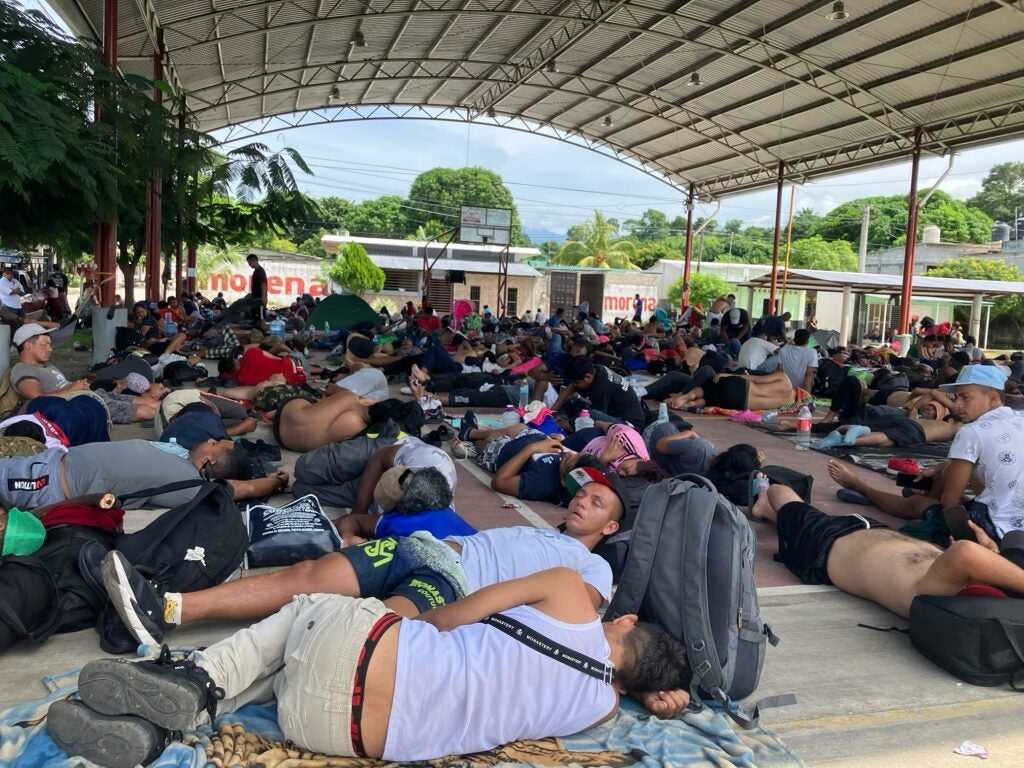тАЬYou need to be luckyтАЭ with the app, said Angelo, 25, a construction worker from Peru, as he walked in the early morning to avoid daytime temperatures topping 90 degrees. He spent less than a week in Tapachula but saw an expanding migrant population and fewer and fewer jobs to sustain himself. тАЬI prefer to walk and turn myself in to U.S. authorities,тАЭ he said. тАЬIтАЩve had the American dream since childhood.тАЭ
Migrants walking in the caravan expressed misgivings over insecurity in TapachulaтАФwith two saying they were kidnapped upon entering Mexico.
Luis, a 35-year-old Venezuelan in the caravan, says he was тАЬtricked by a kid,тАЭ who offered him a motorcycle ride up the road upon entering Mexico. He spent five days in a safehouse until family in Venezuela sent $200 via Western Union. Luis has a screenshot of the receipt. He also has a photo of the stamp on his armтАФresembling a fighting cockтАФthat his captors left on his arm, allowing him passage for roughly 20 miles to the border.┬а
тАЬI donтАЩt like Mexico,тАЭ he said, adding that if he failed to reach the United States, he would rather head back to Venezuela than stay in Mexico.┬а
 Luis, a migrant from Venezuela, applies for an appointment to enter the United States through the CBP One app, while resting Oct. 9 in Mapastepec, Mexico after walking during the predawn hours as part of a caravan. (David Agren/Associated News Service)
Luis, a migrant from Venezuela, applies for an appointment to enter the United States through the CBP One app, while resting Oct. 9 in Mapastepec, Mexico after walking during the predawn hours as part of a caravan. (David Agren/Associated News Service)
Others express an urgency to reach the United States prior to the Jan. 20 change of presidential administrationsтАФamid misgivings over TrumpтАЩs plan for mass deportations and rumors of the CBP One app being disbanded.
 Caravan travelers rest Oct. 9 on a public basketball court in Mapastepec, Mexico, after walking through the night to beat temperatures reaching 95 degrees. The migrants formed a caravan over frustration with the CBP One app, which provides 1,450 daily appointments for entering the United States at an authorized port of entry. (David Agren/Associated News Service)
Caravan travelers rest Oct. 9 on a public basketball court in Mapastepec, Mexico, after walking through the night to beat temperatures reaching 95 degrees. The migrants formed a caravan over frustration with the CBP One app, which provides 1,450 daily appointments for entering the United States at an authorized port of entry. (David Agren/Associated News Service)
тАЬWeтАЩre fearful that during the elections the president will get rid of humanitarian parole and the CBP One app,тАЭ said Jos├й, 28, a caravan organizer and Venezuelan migrant. тАЬAt that point everything would be up in the air. тАж WeтАЩre trying to move quickly, but itтАЩs hard because we have children, old people, and pregnant womenтАЭ in the caravan.
Jos├й later clarified that he was only worried about Trump, saying of Harris, тАЬThe vice president running is already with migrants.тАЭ
Edited by Roy Maynard of the Associated News Service.
Source link : http://www.bing.com/news/apiclick.aspx?ref=FexRss&aid=&tid=671b6933d7c04d2a9e69ebbe9108a91a&url=https%3A%2F%2Fwww.dailysignal.com%2F2024%2F10%2F25%2Fwith-its-control-of-migrant-flow-mexico-seeks-to-play-key-role-in-us-election%2F&c=9717280194956024600&mkt=en-us
Author :
Publish date : 2024-10-24 22:35:00
Copyright for syndicated content belongs to the linked Source.












